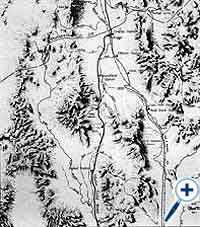The
Idaho Gold Road
Before railroads were built
there were stage lines and freight wagons. As trade increased between the Mormon
settlements in Utah and the mines in Montana to the north, Ben Holladay, opened
in 1864, a stagecoach service along the "Idaho Gold Road" from Corinne,
Utah (on the transcontinental railroad) to Virginia City, Montana, via Eagle
Rock. South of the Snake River two stage routes existed, the Bannock Road, which
went northwest from Malad into Hawkins Basin and Arbon Valley,
and the Portneuf Road followed by Holladay's stages, which went north, following
present-day Interstate 15. The success of these stage lines plus the decision
by the Mormon Church to build rails northward from Salt Lake City to Montana
opened Idaho to the railroad era of the turn of the century.
Eagle
Rock
In the early 1860s
the Snake River was a major barrier on the trip north to the gold fields of
Montana. In May, 1863, a ferry was constructed near the ford used by Indians
to cross the Snake about nine miles upstream from what was then Eagle Rock.
Matthew Taylor built the first bridge across the Snake River at Eagle Rock,
using poles from Beaver Canyon, 80 miles to the north. The abutments were set
in place on a frozen river in January, 1865. The bridge opened in May and stood
a block south of present day Broadway Street bridge in Idaho Falls. The bridge
was flooded and gave way in June, 1867. The bridge was rebuilt and lasted until
1889 when it was declared a public highway and replaced by an iron bridge. The
name of Eagle Rock was changed to Idaho Falls in a referendum in January 1890.
Port
Neuf Toll Bridge
In 1864 William
Murphy built a cabin and a toll bridge on the Portneuf River in Marsh Valley
(at present-day McCammon, then called Port Neuf), mainly to service the stage
business of Ben Holladay and the growing freight wagon business. In 1865, Murphy's
wife Catherine became the first Anglo-American woman to live in Marsh Valley.
Murphy acquired the Port Neuf toll road in 1866. He was a passionate and hot
headed Irishman who died from the bullet of an Oneida County Sheriff during
an argument outside a bar in Malad City in April, 1870.
After Murphy's death, Henry
O. Harkness, a Civil War veteran who had been employed by Murphy to operate the
toll store and gate in Beaver Canyon, south of Monida Pass, was requested by widow
Catherine Murphy to take over operation of the stage line. A year later, in August,
1871 Henry Harkness and Catherine Murphy were married. In the next 40 years he
built a farming and ranching empire, a power generation facility, a flour mill,
and a hotel to serve the new railroad.
top
